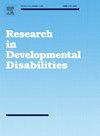Symbolated texts as an assistive technology: Exploring the impact on reading comprehension
IF 2.6
2区 医学
Q1 EDUCATION, SPECIAL
引用次数: 0
Abstract
Background
It is widely assumed that pairing graphic symbols with text supports individuals with intellectual and developmental disabilities (IDD) in accessing written content. As a result, these symbolated texts are often used as an assistive technology to increase text accessibility. Unfortunately, there is little empirical evidence that symbolated texts improve reading comprehension. Research with beginning and struggling readers suggests that pairing text with any type of image makes understanding text more difficult and impedes reading growth by distracting individuals’ visual attention away from the text on the page. Despite this, there continues to be widespread use of symbolated texts.
Aims
The purpose of this study was to investigate the impact of symbolated text on the reading comprehension of individuals with IDD.
Method and procedures
Objective measures of reading comprehension and reading-level matched texts with and without graphic symbols were used to: (a) compare comprehension scores across text-type; (b) investigate the impact of symbols on reading rate; and (c) look for relationships between reading rate and reading comprehension scores.
Outcomes and results
Results suggest that reading comprehension scores are significantly lower for symbolated texts than traditional texts. Additionally, pairing graphic symbols with text resulted in significantly slower reading times.
Conclusions and implications
The findings suggest that symbolated texts may not make texts more accessible for individuals with IDD. Rather, they may actually make content less accessible. Anyone producing texts for this population should be cautious about pairing graphic symbols with text.
符号文本作为一种辅助技术:探讨其对阅读理解的影响
人们普遍认为,将图形符号与文本配对有助于智力和发育障碍(IDD)患者获取书面内容。因此,这些符号文本经常被用作辅助技术来增加文本的可访问性。不幸的是,很少有经验证据表明符号化文本可以提高阅读理解能力。对初识读者和阅读困难的读者进行的研究表明,将文本与任何类型的图像配对会使理解文本变得更加困难,并且会分散个人的视觉注意力,使其远离页面上的文本,从而阻碍阅读的发展。尽管如此,符号化文本仍然被广泛使用。目的探讨符号化文本对缺乏症患者阅读理解的影响。方法和步骤使用阅读理解和阅读水平的客观测量方法来匹配有和没有图形符号的文本:(a)比较不同文本类型的理解分数;(b)研究符号对阅读速度的影响;(c)寻找阅读速度和阅读理解分数之间的关系。结果和结果结果表明,符号文本的阅读理解分数明显低于传统文本。此外,将图形符号与文本配对会导致阅读时间明显变慢。结论和意义研究结果表明,符号文本可能不会使IDD患者更容易获得文本。相反,它们实际上可能会使内容更难以访问。任何为这一群体编写文本的人都应该谨慎地将图形符号与文本配对。
本文章由计算机程序翻译,如有差异,请以英文原文为准。
求助全文
约1分钟内获得全文
求助全文
来源期刊

Research in Developmental Disabilities
Multiple-
CiteScore
5.50
自引率
6.50%
发文量
178
期刊介绍:
Research In Developmental Disabilities is aimed at publishing original research of an interdisciplinary nature that has a direct bearing on the remediation of problems associated with developmental disabilities. Manuscripts will be solicited throughout the world. Articles will be primarily empirical studies, although an occasional position paper or review will be accepted. The aim of the journal will be to publish articles on all aspects of research with the developmentally disabled, with any methodologically sound approach being acceptable.
 求助内容:
求助内容: 应助结果提醒方式:
应助结果提醒方式:


